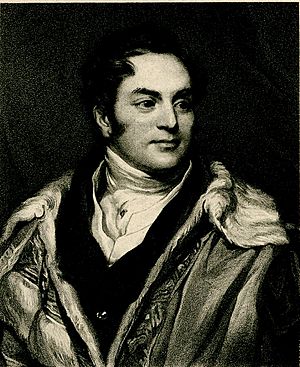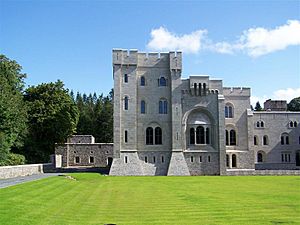Archibald Acheson, 2nd Earl of Gosford facts for kids
Quick facts for kids
The Earl of Gosford
|
|
|---|---|
 |
|
| Member of Parliament for County Armagh | |
| In office 1801–1807 |
|
| Preceded by | New constituency |
| Succeeded by | Henry Caulfeild William Brownlow |
| Personal details | |
| Born |
Archibald Acheson
1 August 1776 Markethill, County Armagh |
| Died | 27 March 1849 (aged 72) |
| Spouse | Mary Sparrow |
| Children | Archibald Acheson, 3rd Earl of Gosford Lady Mary Acheson Lady Millicent Acheson |
| Parents |
|
Archibald Acheson, 2nd Earl of Gosford (born August 1, 1776 – died March 27, 1849) was an important British politician. He served as the Lieutenant-Governor of Lower Canada and the Governor General of British North America in the 1800s.
Contents
Early Life and Family
Archibald Acheson was born on August 1, 1776, in Markethill, County Armagh, which is in Ireland. His father was Arthur Acheson, 1st Earl of Gosford, and his mother was Millicent Pole. When his father passed away in 1807, Archibald took over his father's titles and lands.
Political Career
Archibald Acheson started his political journey in the Irish House of Commons. He represented County Armagh from 1798. In 1801, Ireland joined with Great Britain to form the United Kingdom. After this, he became a Member of the British House of Commons for Armagh. He served there until 1807, when he became the Earl of Gosford.
In 1811, he joined the British House of Lords. This was a special role for Irish nobles. In 1831, he became the first Lord Lieutenant of Armagh for life. This was a very important position in his home county. He also started building a new, grand home called Gosford Castle on his estate. However, it was not finished until after he died.
Governor General in Canada
In 1835, Lord Gosford was given a big job. He became the Governor General of British North America. This also meant he was the Lieutenant-Governor of Lower Canada. His main goal was to try and calm down the people who wanted more changes in the government. These people were led by Louis-Joseph Papineau.
Lord Gosford tried to be different from the previous governor. He wanted to make the French-Canadians feel less angry with the British government. He also officially created the Diocese of Montreal in 1836.
However, things became difficult. In August 1836, he had to close the local assembly. This happened because they would not approve his budget plans.
Lower Canada Rebellion
In November 1837, Lord Gosford found out about a planned uprising called the Lower Canada Rebellion. He ordered the arrest of many of Papineau's supporters. Papineau himself managed to escape to the United States. The next month, Lord Gosford offered a reward for Papineau's capture. He also declared a special rule by the military in Lower Canada to keep order.
Lord Gosford resigned from his role in November 1837. He returned to Britain the following year. Another governor, Lord Durham, took over in 1838. Lord Durham later wrote a famous report. This report suggested that Lower Canada and Upper Canada should join together. It also recommended that the government should be more responsible to the people. Lord Gosford had actually disagreed with this idea.
Personal Life
Lord Gosford married Mary Sparrow. She was the daughter of Robert Sparrow. They had one son and four daughters together.
- His son, Archibald Acheson, 3rd Earl of Gosford (born August 20, 1806 – died June 15, 1864), became the next Earl of Gosford after his father passed away.
- His daughter, Lady Mary Acheson (born June 27, 1809 – died March 13, 1850), married James Hewitt, 4th Viscount Lifford.
- Another daughter, Lady Millicent French Acheson (born around 1812 – died August 29, 1887), married Henry Bence Jones.
Lord Gosford died in 1849.
Legacy
The city of Gosford in New South Wales, Australia, is thought to be named after him. The Governor of New South Wales at the time had worked with Lord Gosford in Canada.
See also


